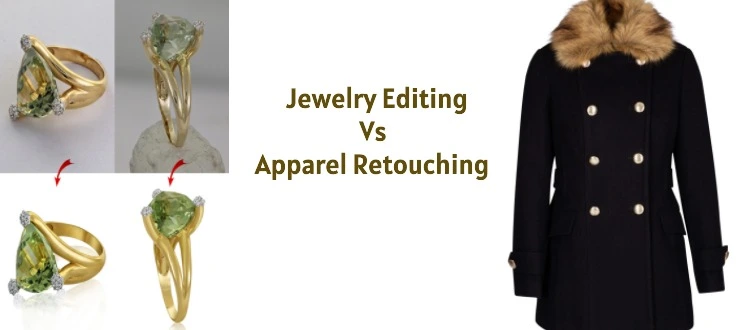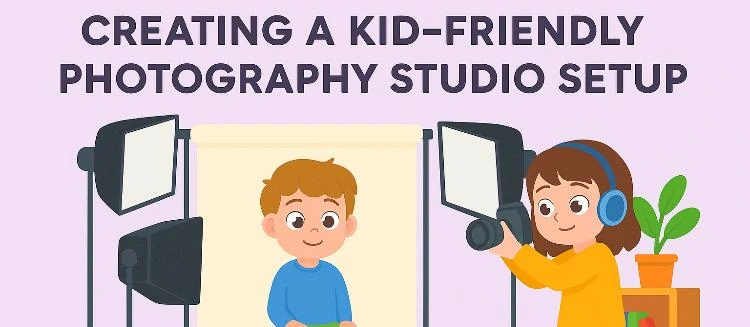Theodore Lowe, Ap #867-859
Sit Rd, Azusa New York
Find us here
How Jewelry Editing Differs from Apparel Retouching

Jewelry editing and apparel retouching are two distinct processes that transform ordinary images into captivating visuals. But how do these techniques differ, and why should you care? Understanding these differences can empower you to make informed choices, whether you're a photographer aiming to refine your craft or a consumer craving a deeper appreciation of visual aesthetics.
Dive into this article to discover the fascinating nuances of jewelry and apparel editing, and unlock the secrets behind those stunning images that capture your attention.
Jewelry Editing Techniques
Jewelry editing techniques require a unique blend of skills and creativity. Unlike apparel retouching, which often focuses on fabric textures and fitting, jewelry editing is all about emphasizing the sparkle and intricate details. It's a specialized process that demands precision, knowledge of lighting effects, and a keen eye for reflection.
Precision And Detail
Jewelry editing is all about precision. Each piece of jewelry has unique characteristics like tiny engravings, delicate settings, and varied gemstone cuts. You need to pay attention to these subtle details to ensure the final image captures the essence of the piece.
Imagine editing a diamond ring. Every facet must reflect light perfectly, showing off its brilliance. In apparel, you might focus on smoothing wrinkles or adjusting colors, but with jewelry, the tiniest flaw can distract the viewer.
Have you ever tried highlighting the intricate carvings on a bracelet? It requires tools that allow for zooming and fine-tuning each detail. This level of detail is crucial to make the jewelry look enticing and authentic.
Lighting And Reflection
Lighting plays a crucial role in jewelry editing. Proper lighting can make gems shine and metals gleam, creating a captivating effect. It's not just about brightness; it's about creating shadows and highlights that add depth to the image.
Consider how lighting affects a pearl necklace. The right lighting reveals the pearl's luster while maintaining its natural color. You need to balance the light to enhance the product without washing out its hues.
Reflection is another key aspect. Jewelry often reflects its surroundings, which can be tricky in editing. You must manage these reflections to avoid unwanted distractions. Have you ever noticed how a watch face can mirror other objects? Careful editing ensures these reflections add rather than detract from the visual appeal.
Jewelry editing techniques require a distinct approach compared to apparel retouching. How do you ensure every gemstone and metal piece looks perfect? It's a question worth pondering as you refine your editing skills.
Apparel Retouching Methods
Apparel retouching methods are essential for showcasing garments in their best light. Whether you're scrolling through an online store or flipping through a fashion magazine, the polished images you see are the result of meticulous editing. But what does it take to make fabric look flawless on screen? Let's dive into the specifics.
Fabric Texture Enhancement
Enhancing fabric texture is a crucial step in apparel retouching. It's about making the fabric's unique qualities pop without losing its natural appeal. For instance, when retouching a wool sweater, you want to emphasize the fibers' softness while retaining the sweater's cozy look.
Do you remember the last time you bought a silk blouse online and were amazed at how smooth it looked? That's the magic of fabric texture enhancement. Editors meticulously adjust lighting and shadows to highlight the fabric's sheen and flow. This method ensures the garment's tactile qualities are visible, enticing you to add it to your cart.
Color Correction
Color correction in apparel retouching is all about accuracy. You've probably experienced the frustration of receiving a dress that looked vibrant online but dull in person. Precise color correction prevents this disappointment.
Editors use advanced tools to match the garment's color to reality. This involves adjusting hues, saturation, and brightness. Imagine you're editing a red dress; the goal is to capture that exact shade of red that will dazzle in person as it does on screen. Color correction ensures you see the garment as it truly is, sparking your confidence in your purchase.
Apparel retouching methods are about more than just making clothes look good. They're about bridging the gap between digital and real-world experiences. By understanding these techniques, you can appreciate the artistry behind every garment image you see.
Software Tools And Applications
Jewelry editing focuses on enhancing shine and highlighting intricate details. Apparel retouching emphasizes fabric texture and fit. Each requires different software tools and techniques for optimal results.
In the world of digital editing, jewelry and apparel retouching require distinct software tools and applications. Each demands a unique approach to achieve the desired perfection. Jewelry editing focuses on enhancing intricate details. Apparel retouching emphasizes texture and fit. The choice of software plays a crucial role in both cases.
Photo Editing Software
Photo editing software like Adobe Photoshop is widely used. It offers flexibility and advanced features. Jewelry editing uses tools for precise color correction. Clarity and shine are essential in jewelry images. Apparel retouching uses these tools differently. The focus is on fabric texture and correcting wrinkles. Both require keen attention to detail. But their priorities differ.
Specialized Plugins
Specialized plugins extend the capabilities of basic software. Jewelry editing benefits from plugins enhancing reflections and shine. These plugins help in making gems sparkle realistically. Apparel retouching plugins target fabric texture and pattern repetition. They assist in maintaining the natural look of the fabric. These tools simplify complex tasks, ensuring high-quality results. Each plugin serves a unique purpose in the editing process.
Challenges In Jewelry Editing
Jewelry editing requires precision to highlight intricate details and reflections, unlike apparel retouching's focus on fabric and fit. Achieving the perfect shine and color balance in jewelry demands advanced techniques and software. This process is crucial to showcase the elegance and craftsmanship of each piece.
Jewelry editing presents a unique set of challenges that can perplex even the most seasoned photo editors. Unlike apparel retouching, where fabric and fit take center stage, jewelry editing demands precision and attention to detail. The task involves handling intricate designs, achieving a lifelike appearance, and ensuring every sparkle and shadow are just right.
Handling Complex Structures
Jewelry often features intricate patterns and delicate details. These can be difficult to edit without losing the original design's essence. I once spent hours working on a vintage necklace, where each link had a distinct texture and shine. Preserving these nuances without distorting the overall look required meticulous attention. Have you ever wondered how to maintain the integrity of such complex structures while editing?
Achieving Realism
Capturing the true essence of a jewelry piece in a photo is challenging. The way light hits a diamond or the subtle hue of a gemstone needs careful enhancement to appear realistic. I remember working on a sapphire ring, struggling to achieve the perfect shade of blue that matched its real-life counterpart. The key is to enhance, not overdo, ensuring the jewelry looks as stunning on screen as it does in person. Editing jewelry is not just about making it look good; it’s about making it look real. What techniques do you use to ensure your edits achieve realism?
Apparel Retouching Challenges
Apparel retouching presents unique challenges that differ from jewelry editing. Each piece of clothing has its own set of issues. These can range from fabric imperfections to maintaining the garment's natural look. Understanding these challenges helps improve the quality of the final image. Let's explore some of these apparel retouching challenges in detail.
Managing Drapes And Folds
Handling drapes and folds is a big challenge in apparel retouching. Fabrics like silk or satin can be tricky. They often need special attention to look perfect. Natural drapes give a garment its shape and character. Retouchers must keep these intact while removing unwanted creases. This ensures the clothing looks elegant and realistic.
Ensuring Consistent Branding
Brand consistency is vital for apparel images. Each brand has a unique style and color scheme. Retouchers must ensure colors match the brand's identity. Even small deviations can affect brand perception. Retouching must also maintain the garment's fit and finish. This ensures the clothing appears high-quality and desirable.
Comparative Analysis
When you think about photo editing, apparel retouching and jewelry editing might seem similar at first glance. However, when you dive into the details, the differences become clear and significant. This comparative analysis will shine a light on how these two types of editing require distinct approaches and skills.
Time And Effort
Jewelry editing demands meticulous attention to detail. Imagine trying to capture the brilliance of a diamond or the intricate design of a necklace; every facet needs to sparkle perfectly.
This process is time-consuming, often requiring hours to achieve the desired result. Apparel retouching, while still detailed, often focuses on broader aspects like fabric texture and overall silhouette, which can be quicker.
Have you ever wondered why jewelry in advertisements looks flawless? It’s because of the extensive time and effort invested in perfecting each image.
Skillset Requirements
Jewelry editing requires a keen eye for detail and a steady hand. You need to be familiar with techniques that enhance shine and clarity, ensuring that every gemstone looks its best.
If you've ever tried to edit a piece of jewelry, you know the challenge of maintaining its authenticity while enhancing its appeal. Apparel retouching, on the other hand, focuses more on managing colors and textures, requiring skills in fabric manipulation and body shaping.
Think about the last time you admired a beautifully retouched gown; the skills involved are different but equally impressive. Which skillset do you think would be more challenging to master?
Industry Standards And Expectations
Jewelry editing and apparel retouching differ significantly in their standards. Each has unique expectations within the industry. Jewelry editing requires precision and attention to detail. Apparel retouching focuses on fabric texture and color consistency.
These differences shape how editors approach their tasks. Understanding these standards is crucial for meeting client needs. The goal is always to maintain brand integrity and visual appeal.
Quality Control Measures
Jewelry editing involves strict quality checks. Any flaw can affect customer perception. Editors must ensure stones sparkle and metals shine. Each piece needs to look flawless and attractive.
Apparel retouching also follows quality measures. Editors look at fabric flow and fit. Colors must match the brand's style and design. Both types of editing require accuracy and keen observation.
Client Specifications
Clients in both sectors have specific needs. Jewelry clients often request emphasis on clarity and luster. They may want certain stones to stand out more. Each piece should reflect luxury and elegance.
Apparel clients focus on style representation. They may specify fabric texture and pattern visibility. The final image should capture the essence of the garment. Meeting these requirements is vital for client satisfaction.
Conclusion
Jewelry editing and apparel retouching are distinct in their demands. Jewelry requires precision and keen attention to details. Every sparkle matters. Apparel retouching focuses on textures and fabric flow. Each enhances visual appeal differently. Both demand unique skills and techniques.
Mastering these can elevate your brand's image. Quality editing influences customer perception. Investing in skilled editors pays off. Better images lead to higher engagement. Understanding these differences is crucial. Tailor your approach based on needs. Choose the right experts for your products.
Enhance beauty, capture interest, and drive success.
Related blog posts
Creating a Kid-Friendly Studio Setup: Ultimate Guide
Imagine capturing the pure joy and energy of children in your clothing photography. Sounds exciting, right?


